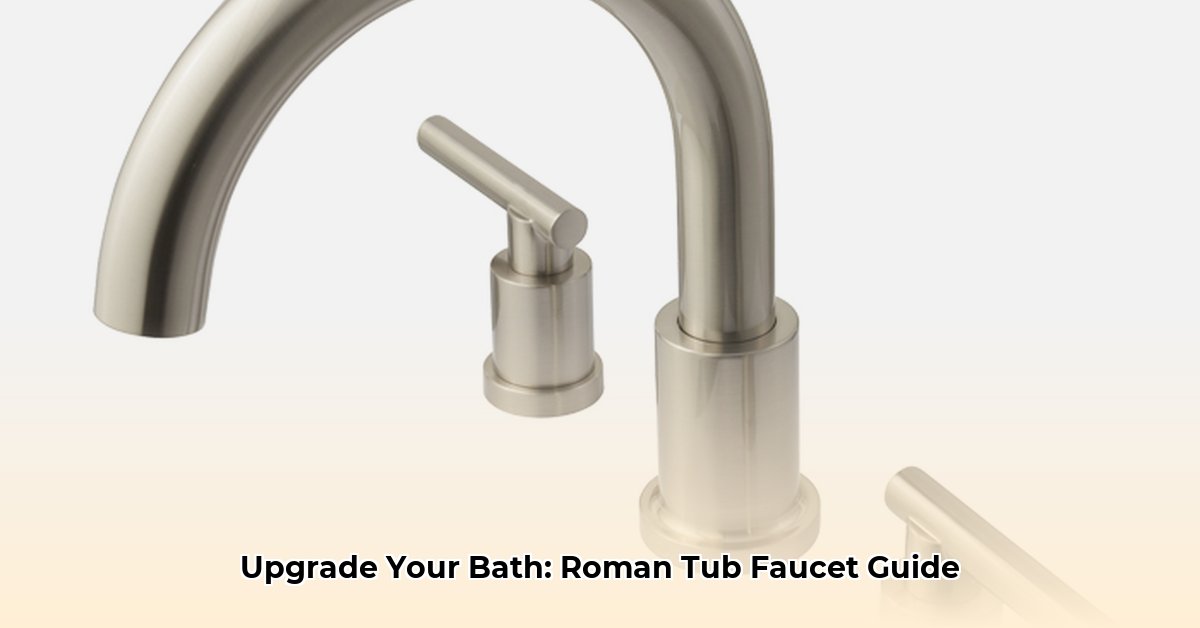Ready to elevate your bathroom into a spa-like retreat? A Roman tub faucet is the ultimate finishing touch, creating a luxurious soaking experience that transforms your daily routine. Choosing the right faucet, however, can feel overwhelming with so many styles, features, and finishes available. This comprehensive guide will walk you through everything you need to know to find the perfect Roman tub faucet for your bathroom, budget, and personal style, from understanding the different types and their features to hassle-free installation tips and maintenance guidance. We’ll also cover considerations for low water pressure and small bathroom spaces. For more inspiration, check out these stunning Roman tub designs.
Roman Tub Faucets: Finding Your Perfect Match with the Right Style
Are you dreaming of a luxurious soak in your Roman tub? Staring at countless faucet options leaving you feeling lost? This section helps you navigate the world of Roman tub faucets and find the perfect one for your needs. Let’s explore the features of Roman tub faucets to elevate your bathroom and enhance your bathing experience.
Understanding Your Roman Tub Faucet Options: Exploring Key Features
First, what exactly is a Roman tub faucet? It’s the sophisticated spigot system designed for your deep-soaking tub. These faucets are typically mounted on the deck (rim) of the tub, rather than on the wall. They are available in a couple of main styles:
-
Two-Handle Faucets: Embodying classic elegance, these faucets feature separate knobs for both hot and cold water, allowing you to precisely fine-tune the water temperature to your preference. They often provide a more traditional aesthetic and are favored by those who appreciate a classic design.
-
Single-Handle Faucets: Offering a modern, minimalist aesthetic, these faucets use a single lever to control both water temperature and flow with effortless ease. They are ideal for contemporary bathrooms and offer ease of use.
Beyond handle type, consider these key features for a better bath experience:
-
Spout Height & Reach: Ensure the spout height matches your tub’s depth for easy filling. A higher spout effortlessly fills the tub, while a shorter spout suits shallower tubs. Consider the arc of the spout as well; a longer reach ensures the water stream lands comfortably within the tub.
-
Handheld Shower: Do you really need the rinsing flexibility a handheld shower offers? This feature is perfect for cleaning your tub, rinsing hair, or enjoying a targeted shower. If you have children or pets, a handheld shower can be especially useful.
-
Finish: From classic chrome to sleek brushed nickel or rustic oil-rubbed bronze, your faucet’s finish should complement your bathroom’s style, acting as the jewelry of your tub! Consider the other fixtures in your bathroom when selecting a finish to ensure a cohesive look. Popular finishes also include polished brass, matte black, and white.
Choosing the Right Roman Tub Faucet: A Personalized Approach and Modern Functionality
Picking the right faucet requires thinking about your preferences and your bathroom’s layout. Here’s a step-by-step process to simplify the selection:
Step 1: Handle Type – Precision or Simplicity? Do you crave the precise temperature control of a two-handle model, or the streamlined ease of a single-handle one? Consider the overall aesthetic you’re aiming for. Two-handle faucets often lend themselves to more traditional designs, while single-handle faucets fit well in modern spaces.
Step 2: Spout – Reach for the Sky (or Not)? Measure your tub’s depth and the distance from the faucet mounting point to the center of the tub to ensure the spout efficiently fills your tub without splashing. Visualize the water flow – it should be efficient and even. Consider an adjustable spout if you are unsure of the precise measurements.
Step 3: Handheld Shower – A Luxury or a Necessity? Is the added convenience of a handheld shower worth the added cost and potential clutter? Weigh the pros and cons based on your bathing habits. If you plan to use it frequently for cleaning or rinsing, it’s a worthwhile addition.
Step 4: Finish – The Finishing Touch. Select a finish that blends beautifully with your bathroom’s décor. Browse online or visit showrooms to see finishes in person. Take samples of your tile, countertop, and cabinetry with you to ensure a perfect match.
Step 5: Budget – Setting Realistic Expectations. Roman tub faucets range in price from a few hundred to over a thousand dollars – depending on the materials used (brass is often more expensive than zinc), brand name, and features. Set a realistic budget before you start shopping to avoid buyer’s remorse. Consider potential installation costs as well.
Installation: DIY or Call in the Pros for Optimal Faucet Performance?
Installing a Roman tub faucet is more involved than changing a light bulb. It’s best to hire a qualified plumber due to working with plumbing components, especially if you are unfamiliar with plumbing. Incorrect installation can lead to leaks and costly water damage. While DIY installation is possible, it requires a thorough understanding of plumbing principles and the use of specialized tools. Videos might be helpful, but it’s better to err on the side of caution and call in the experts unless you have significant plumbing experience.
Before the installation, carefully inspect all components of the faucet to ensure nothing is missing or damaged. Also, make sure you have all the necessary tools and materials on hand before you begin.
Maintaining Your Roman Tub Faucet: Ensuring Faucet Longevity
Regular maintenance can keep your faucet looking fabulous and functioning optimally. Consider these tips:
-
Regular Cleaning: Wipe down your faucet after each use to prevent water spots, soap scum, and mineral buildup and extend its life. Use a soft cloth and a mild soap solution.
-
Leak Detection: Regularly check for any leaks around the faucet handles, spout, and connections, addressing any issues quickly. Even small leaks can waste a significant amount of water over time and can lead to water damage.
-
Deep Cleaning: Periodically, use a mild cleaner designed for faucets to remove stubborn mineral deposits, avoiding harsh chemicals. Harsh chemicals can damage the finish of your faucet. Consider using a mixture of vinegar and water to remove mineral deposits.
-
Aerator Cleaning: If your faucet has an aerator, clean it regularly to remove any debris that may be clogging it. A clogged aerator can reduce water flow and pressure.
Budgeting and Pricing: A Comprehensive Guide to Roman Tub Faucets
Prices for Roman tub faucets vary based on features, materials, and brand. While basic models might range from $100 to $300, high-end faucets can easily exceed $1000. Consider exploring different brands and looking for sales. Keep in mind that higher-priced faucets often come with better warranties and customer support.
| Faucet Type | Price Range (USD) | Material Examples | Considerations |
|---|---|---|---|
| Basic | $100 – $300 | Zinc, Plastic | Fewer features, simpler design, potentially shorter lifespan. |
| Mid-Range | $300 – $700 | Brass, Ceramic | More features, durable materials, longer lifespan. |
| High-End | $700+ | High-grade Brass, Premium Finishes | Top-of-the-line features, luxurious materials, extended warranty. |
Remember, these are estimated ranges, actual prices may vary. Prices can also fluctuate based on retailer and current promotions.
Final Thoughts: Your Dream Bath Awaits with the Perfect Shower System!
Finding the perfect Roman tub faucet is a journey. Compare features and set a clear budget. The right faucet will elevate your bathroom’s style and transform your daily bathing experience into a tranquil escape. Consider the long-term value and enjoyment the right faucet can bring.
How to Choose the Best Roman Tub Faucet for Low Water Pressure and Long-Lasting Performance
Dreaming of a luxurious Roman tub experience but worried about low water pressure? You’re not alone. Let’s explore how to find the perfect faucet for great water flow even when the pressure isn’t ideal.
Understanding Roman Tub Faucets: A Deeper Look
Roman tub faucets add elegance and functionality to your bathroom, featuring a high spout and sometimes a hand shower. You’ll find them in various styles; two-handle designs offer a classic look, while single-handle models provide a streamlined look and easy temperature adjustment. The design adds a touch of classic sophistication to any bathroom.
How to Choose the Best Roman Tub Faucet for Low Water Pressure: Overcoming Flow Challenges
Low pressure doesn’t mean compromising on style or function. Here’s how to find a faucet that thrives even with limited water flow:
-
Assess Your Current Pressure: Use a pressure gauge (available at most hardware stores) to understand your existing water pressure. Knowing the PSI (pounds per square inch) will help you determine what type of faucet is suitable. A reading below 40 PSI is generally considered low.
-
Prioritize High-Flow Faucets: Look for faucets specifically designed for low-pressure situations. Manufacturers often highlight this in the product descriptions and product specifications. Words like “low-flow” or “pressure-assist” are good indicators.
-
Consider Faucet Type: Two-handle faucets can sometimes offer slightly better pressure control than single-handle models in low-pressure situations, as you can adjust the hot and cold water flow independently.
-
Check the Flow Rate: Pay attention to the manufacturer’s flow rate (gallons per minute or GPM). While
- Ceramic Kitchen Wall Tiles: Style and Protection for Your Walls - December 17, 2025
- Kitchen tiling wall: Elevate your kitchen with stylish wall tiles - December 16, 2025
- Gray Kitchen Backsplash Tile: Ideas for a Stylish Upgrade - December 14, 2025









